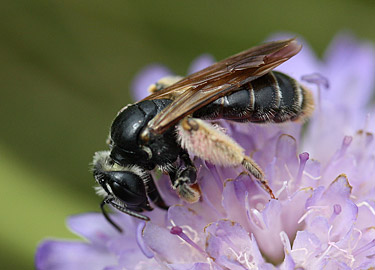The UK Bees, Wasps and Ants Recording Society (BWARS)
BWARS is a subscription based volunteer recording society, operating under the aegis of the UK Biological Records Centre (BRC). The Society is affiliated to the British Entomological and Natural History Society (BENHS).
The Society aims to promote the recording of aculeate Hymenoptera in Great Britain and Ireland, and to foster links with similar societies and interested individuals throughout Europe.
There are about 500 members (including museum and university professionals and overseas “Corresponding Members”) whose activities are directed by a small committee which guides policy. The vast majority of members are enthusiastic volunteer naturalists, without whom BWARS could not hope to gather the large amounts of data it requires.
The Society exists to gather distribution and biological data on the aculeate Hymenoptera (which includes many important pollinators), to provide advice and training to society members and the general public, and to promote understanding of aculeates.
The Society is prepared to consider making data available for specific purposes upon application to the Society via the NBN. Data at 10km resolution is freely available and may be downloaded from the Data Download Page.
The Society provides advice, via Hymettus, to the 3 statutory countryside agencies in England, Scotland and Wales.
Data is handled by a team of members who collect and process the data, preparing it for wider use. The process consists of a number of steps to validate then verify incoming data, using tools developed for BWARS. The fully cleaned and trimmed dataset is now in excess of 800,000 records. A public version of this, at 10km resolution, is available at https://www.bwars.com/content/bwars-data-download in both a CSV format and as a Shapefile. Anyone needing specific access is encouraged to contact BWARS, though please note that BWARS does not offer assistance with interpretation.

Andrena hattorfiana female on common scabious by Nick Owens
The Society publishes 2 newsletters a year, and (in association with the Centre for Ecology and Hydrology) a part of the Provisional Atlas of the Aculeate Hymenoptera of Britain and Ireland every 2 years (in which some 60 species are mapped at the resolution of 10x10km).
If you would like to join BWARS, membership is set at £20 per annum, which, as a new member, entitles you to the Members Handbook. More details are here.
The need for organised recording of aculeates
There is an urgent need for proper, well co-ordinated data on the distribution and habitats for many animals to support conservation programmes, ecological research, and to promote effective conservation strategies on a national basis (the intended function of the National Conservation Agencies). Such data is not only useful to monitor individual populations or species, but can be used to great effect to predict or diagnose the condition of areas of natural habitat. This is possible because of the sensitivity of many plants and animals, especially insects (because of their great diversity and sheer numbers), to otherwise unobtrusive environmental changes, all too frequently detrimental and man-made.
History of BWARS
Biological Records Centre (BRC), - the foundation
To collate, sort and store data, the BRC was set up in 1964 at Monk's Wood, and since 1991 has been jointly funded by the Natural Environment Research Council (NERC) and the Joint Nature Conservation Committee (JNCC). Information is stored on computer for easy access and comprises data on distribution (principally) and (among others) feeding habits, host records, general behaviour and activity. BRC publishes much of the data from recording schemes as distribution maps.
The Birth of BWARS
BRC helped to set up a number of recording schemes, including those for bumblebees, wasps and ants which were later amalgamated into the Bees, Wasps and Ants Recording Scheme (BWARS). BWARS was started in 1978 with an initiative from the International Bee Research Association. George Else (Natural History Museum, London) ran the whole scheme virtually single-handed until 1986. During this period over 150 members received the Bulletins compiled by George, and a number of field meetings were arranged with the help of Ian McLean and Alan Stubbs (Nature Conservancy Council; now Natural England). The first committee emerged from a public meeting held in May 1986.
Development and expansion 1995-2013
BWARS became a self-funded Society in 1995 (with support from BRC) when the committee decided at a series of meetings in Oxford convened by Chairman Chris O'Toole that it needed greater scope to expand its activities, especially mapping and Atlas production. Further developments took place in the style and presentation of the newsletter under Newsletter Editor Peter Harvey, who oversaw the change from an A4 newsheet to the colour-covered A5 booklet style newsletter that we have today. 2010 saw the introduction of the first of a suite of Information Sheets (in conjunction with Hymettus).

